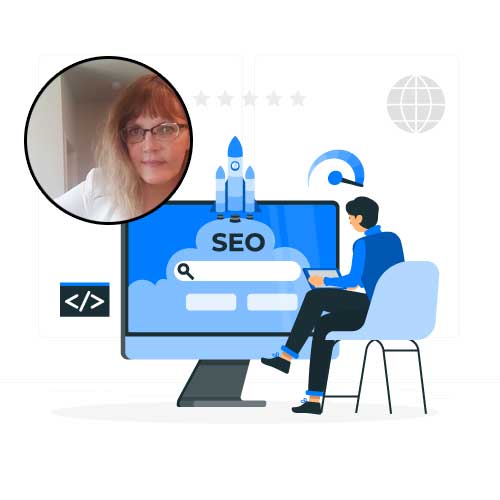
Apr 12, 2024 | SEO
Ranking high in Google’s search results is a goal shared by bloggers, businesses, and content creators worldwide. Achieving a top spot can significantly increase your visibility, drive traffic to your site, and boost your credibility. Here’s a detailed guide on how to optimize your website and content for Google using the latest Search Engine Optimization (SEO) strategies.
1. Understand Your Audience and Keywords
Know Your Audience: Before diving into SEO, understand who your target audience is and what they are looking for. This insight guides your content creation and SEO strategy.
Keyword Research: Use tools like Google Keyword Planner, Ahrefs, or SEMrush to find keywords that are relevant to your content. Look for keywords with high search volume and low competition that your target audience is searching for.
2. Optimize Website Structure
Mobile-Friendliness: Google prioritizes mobile-friendly websites. Ensure your site is responsive and looks good on mobile devices.
Site Speed: Speed is a ranking factor. Use tools like Google’s PageSpeed Insights to analyze and improve loading times.
Secure Site (HTTPS): Google gives preference to secure websites. If you haven’t already, switch from HTTP to HTTPS.
3. Create High-Quality Content
Value and Relevance: Your content should be informative, valuable, and directly relevant to the keywords you’re targeting.
Content Length: Longer content often ranks better, but quality should never be sacrificed for length. Aim for thorough coverage of your topic in a clear and engaging manner.
Use of Keywords: Integrate keywords naturally into your content, especially in the title, headers, and in the first 100 words. Avoid keyword stuffing as it can harm your rankings.
4. Optimize On-Page Elements
Title Tags and Meta Descriptions: These are crucial as they influence click-through rates from search engine results pages (SERPs). Make them descriptive and include main keywords.
Header Tags: Use header tags (H1, H2, H3) to structure your content. Include relevant keywords in at least some of these tags.
Alt Text for Images: Alt text helps search engines understand the content of images. It’s also crucial for accessibility.
5. Focus on Link Building
Internal Links: Link to other pages on your site to help search engines discover more of your content and understand the structure of your website.
Backlinks: High-quality backlinks from reputable sites can significantly boost your rankings. Focus on creating content that is link-worthy and consider outreach to related businesses or blogs for linking opportunities.
6. Utilize Social Media and Content Marketing
While social signals are not a direct ranking factor, they can help increase visibility and drive traffic. Engage on social media platforms and use content marketing strategies to promote your content and attract more visitors.
7. Monitor Performance and Iterate
Google Analytics and Search Console: Use these tools to track your site’s performance. Analyze metrics like traffic, bounce rate, and conversion rate to understand what works and what doesn’t.
Regular Updates: SEO is not a one-time task. Regularly update your content, refresh old posts with new information, and stay on top of SEO trends and Google algorithm updates.
Implementing these SEO strategies will help you improve your Google rankings, attract more visitors, and achieve your website’s goals. Remember, SEO is an ongoing process, and staying informed about the latest trends and algorithm changes is crucial for maintaining and improving your rankings.

Dec 21, 2023 | SEO
How to improve your Internet Service Provider’s (ISP) online presence. SEO is a critical tool for enhancing visibility and attracting more customers.
1. Keyword Research and Optimization: Identify keywords that potential customers use when searching for ISPs. These could include terms like “high-speed internet,” “best ISP near me,” or “reliable internet service.” Once identified, incorporate these keywords into your website’s content, titles, headers, and meta descriptions.
2. Quality Content Creation: Develop engaging and informative content that addresses common customer queries and interests. This could include blog posts about internet speed, tips for securing home networks, or updates on new technologies. High-quality content can attract more visitors and improve search rankings.
3. Local SEO: Since ISPs often serve specific geographic areas, local SEO is crucial. Ensure your business is listed in local directories and Google My Business. Use geo-specific keywords and create content relevant to the local community. Local SEO for ISP companies start at $2100 per month.
4. Mobile Optimization: Ensure your website is mobile-friendly. With more users accessing the internet via smartphones, a mobile-optimized site is essential for good user experience and search rankings.
5. Website Performance Optimization: A fast-loading website provides a better user experience and is favored by search engines. Optimize images, use caching, and consider a Content Delivery Network (CDN) to improve load times.
6. Link Building: Acquire high-quality backlinks from reputable websites. This can be achieved through partnerships, guest blogging, and creating shareable content. Backlinks from trusted sources boost your site’s authority and search ranking.
7. Social Media Engagement: Actively use social media to engage with customers and share content. While social media doesn’t directly impact SEO rankings, it increases brand visibility and drives traffic to your website.
8. Regular Analytics Review: Use tools like Google Analytics to track your website’s performance. Monitor metrics like traffic sources, bounce rate, and conversion rates to understand what’s working and where improvements are needed.
9. User Experience (UX) Optimization: Ensure your website is easy to navigate and provides a positive user experience. A well-structured, user-friendly website can lower bounce rates and encourage longer visits, which positively impacts SEO.
10. Stay Updated with SEO Trends: SEO is an ever-evolving field. Stay updated with the latest trends and algorithm updates from search engines to ensure your strategies remain effective.
By implementing these SEO strategies, your ISP can improve its online visibility, attract more potential customers, and establish a stronger digital presence.

Jul 21, 2023 | SEO
SEO is a complex and ever-evolving field, and the specific actions needed for a website can vary depending on its niche, competition, and current state. Also, search engine algorithms change frequently, so some tactics may become outdated over time. Nevertheless, here is a list of 200 actionable SEO tasks that can be considered:
- Perform keyword research to identify relevant and high-volume search terms to target with SEO.
- Optimize meta titles and descriptions for target keywords.
- Create high-quality, unique, and engaging content.
- Use H1 tags to highlight page titles and include target keywords.
- Add relevant and descriptive alt tags to images.
- Optimize URL structures to be user-friendly and include keywords.
- Ensure your website is mobile-friendly and responsive.
- Improve page load speed for better user experience.
- Enable HTTPS to ensure a secure connection.
- Create an XML sitemap and submit it to Google Search Console.
- Submit your website to Google Search Console and Bing Webmaster Tools.
- Monitor crawl errors and fix broken links.
- Implement a breadcrumb navigation system.
- Use internal linking to connect related content.
- Optimize anchor text for internal links.
- Conduct competitor analysis to identify opportunities.
- Optimize the website’s meta robots directives (indexing and following).
- Use structured data markup (schema.org) to enhance search results.
- Create a Google My Business listing for local SEO.
- Encourage online reviews and respond to them.
- Build high-quality backlinks from authoritative websites.
- Remove or disavow low-quality and spammy backlinks.
- Write guest posts on relevant websites to build authority.
- Optimize page content for featured snippets.
- Implement breadcrumb schema to display breadcrumbs in search results.
- Use a responsive design for better mobile usability.
- Optimize images for smaller file sizes without sacrificing quality.
- Leverage browser caching to speed up load times for repeat visitors.
- Optimize meta tags for social media sharing.
- Implement lazy loading for images and videos to improve load speed.
- Create an informative and compelling “About Us” page.
- Use heading tags (H2, H3, etc.) to structure content effectively.
- Optimize video content and provide transcripts for accessibility.
- Monitor and fix duplicate content issues.
- Remove or consolidate thin and low-quality content.
- Optimize website architecture for easy navigation.
- Implement AMP (Accelerated Mobile Pages) for better mobile performance.
- Set up 301 redirects for removed or changed URLs.
- Create a comprehensive and updated “Privacy Policy” page.
- Set up goals and conversion tracking in Google Analytics.
- Implement a clear call-to-action on every page.
- Use rich media like infographics and videos to enhance content.
- Optimize category and tag pages for relevant keywords.
- Monitor and improve the website’s click-through rate (CTR) in search results.
- Use social media to promote and share your content.
- Add a “Contact Us” page with accurate contact information.
- Implement breadcrumb navigation to help users understand site structure.
- Conduct regular website audits to identify and fix issues.
- Optimize images with descriptive file names and alt tags.
- Implement lazy loading for images and videos to improve page speed.
- Create and optimize product pages with unique content and descriptions.
- Implement rel=”canonical” tags to handle duplicate content.
- Conduct user testing to improve website usability.
- Set up and optimize Google Analytics Enhanced Ecommerce tracking.
- Leverage local SEO strategies for businesses targeting specific areas.
- Regularly update and refresh old content to keep it relevant.
- Use Google’s Search Console Performance report to identify keyword opportunities.
- Optimize website navigation to help users find information easily.
- Write compelling meta descriptions to improve click-through rates.
- Implement a custom 404 error page with helpful links.
- Conduct A/B testing to optimize website elements.
- Create and optimize FAQ pages for common user queries.
- Utilize social sharing buttons on content pages.
- Optimize page headings to include target keywords.
- Use descriptive and keyword-rich URLs.
- Monitor website analytics and make data-driven decisions.
- Implement a content marketing strategy to attract backlinks.
- Optimize your website for voice search queries.
- Improve website accessibility for users with disabilities.
- Utilize branded anchor text for link building.
- Conduct keyword mapping to ensure each page targets specific keywords.
- Write engaging meta descriptions to entice users to click.
- Use LSI keywords (Latent Semantic Indexing) to diversify keyword usage.
- Create and optimize an XML sitemap.
- Optimize the site for local search using location-based keywords.
- Monitor and improve website dwell time (time spent on page).
- Use a unique, descriptive, and keyword-rich title tag for each page.
- Create a mobile app if relevant to your business.
- Implement geotargeting for local businesses.
- Use SSL encryption to secure user data and boost trust.
- Optimize category and archive pages for search engines.
- Conduct regular competitor analysis to stay ahead.
- Optimize your website’s 404 error page with helpful content and links.
- Use social proof (testimonials, reviews) to build trust.
- Optimize site search functionality for user experience.
- Implement breadcrumb navigation to aid user navigation.
- Optimize images and videos for fast loading times.
- Create and optimize content for long-tail keywords.
- Optimize meta descriptions for improved click-through rates.
- Monitor website performance using Google Analytics and other tools.
- Implement hreflang tags for international SEO.
- Use responsive design to ensure mobile-friendliness.
- Optimize website URLs for readability and keywords.
- Optimize for featured snippets by providing concise answers to common questions.
- Use user-generated content to build trust and engagement.
- Create and optimize content for Google Discover.
- Utilize social media marketing to reach a wider audience.
- Optimize product pages with high-quality images and detailed descriptions.
- Conduct link reclamation to fix broken backlinks.
- Use a secure and reputable hosting provider.
- Optimize website navigation for a smooth user experience.
- Implement breadcrumb navigation for easy navigation.
- Use keyword-rich anchor text for internal linking.
- Optimize site speed for better user experience.
- Conduct user testing to identify and fix usability issues.
- Implement breadcrumbs to aid user navigation.
- Optimize internal linking for better crawlability.
- Use a clear and concise URL structure.
- Create and optimize content for long-tail keywords.
- Utilize social media to promote and share your content.
- Optimize product pages with high-quality images and descriptions.
- Conduct link reclamation to fix broken backlinks.
- Use a secure and reputable hosting provider.
- Optimize website navigation for a smooth user experience.
- Implement breadcrumb navigation for easy navigation.
- Use keyword-rich anchor text for internal linking.
- Optimize site speed for better user experience.
- Conduct user testing to identify and fix usability issues.
- Implement breadcrumbs to aid user navigation.
- Optimize internal linking for better crawlability.
- Use a clear and concise URL structure.
- Create and optimize content for long-tail keywords.
- Utilize social media to promote and share your content.
- Optimize product pages with high-quality images and descriptions.
- Conduct link reclamation to fix broken backlinks.
- Use a secure and reputable hosting provider.
- Optimize website navigation for a smooth user experience.
- Implement breadcrumb navigation for easy navigation.
- Use keyword-rich anchor text for internal linking.
- Optimize site speed for better user experience.
- Conduct user testing to identify and fix usability issues.
- Implement breadcrumbs to aid user navigation.
- Optimize internal linking for better crawlability.
- Use a clear and concise URL structure.
- Create and optimize content for long-tail keywords.
- Utilize social media to promote and share your content.
- Optimize product pages with high-quality images and descriptions.
- Conduct link reclamation to fix broken backlinks.
- Use a secure and reputable hosting provider.
- Optimize website navigation for a smooth user experience.
- Implement breadcrumb navigation for easy navigation.
- Use keyword-rich anchor text for internal linking.
- Optimize site speed for better user experience.
- Conduct user testing to identify and fix usability issues.
- Implement breadcrumbs to aid user navigation.
- Optimize internal linking for better crawlability.
- Use a clear and concise URL structure.
- Create and optimize content for long-tail keywords.
- Utilize social media to promote and share your content.
- Optimize product pages with high-quality images and descriptions.
- Conduct link reclamation to fix broken backlinks.
- Use a secure and reputable hosting provider.
- Optimize website navigation for a smooth user experience.
- Implement breadcrumb navigation for easy navigation.
- Use keyword-rich anchor text for internal linking.
- Optimize site speed for better user experience.
- Conduct user testing to identify and fix usability issues.
- Implement breadcrumbs to aid user navigation.
- Optimize internal linking for better crawlability.
- Use a clear and concise URL structure.
- Create and optimize content for long-tail keywords.
- Utilize social media to promote and share your content.
- Optimize product pages with high-quality images and descriptions.
- Conduct link reclamation to fix broken backlinks.
- Use a secure and reputable hosting provider.
- Optimize website navigation for a smooth user experience.
- Implement breadcrumb navigation for easy navigation.
- Use keyword-rich anchor text for internal linking.
- Optimize site speed for better user experience.
- Conduct user testing to identify and fix usability issues.
- Implement breadcrumbs to aid user navigation.
- Optimize internal linking for better crawlability.
- Use a clear and concise URL structure.
- Create and optimize content for long-tail keywords.
- Utilize social media to promote and share your content.
- Optimize product pages with high-quality images and descriptions.
- Conduct link reclamation to fix broken backlinks.
- Use a secure and reputable hosting provider.
- Optimize website navigation for a smooth user experience.
- Implement breadcrumb navigation for easy navigation.
- Use keyword-rich anchor text for internal linking.
- Optimize site speed for better user experience.
- Conduct user testing to identify and fix usability issues.
- Implement breadcrumbs to aid user navigation.
- Optimize internal linking for better crawlability.
- Use a clear and concise URL structure.
- Create and optimize content for long-tail keywords.
- Utilize social media to promote and share your content.
- Optimize product pages with high-quality images and descriptions.
- Conduct link reclamation to fix broken backlinks.
- Use a secure and reputable hosting provider.
- Optimize website navigation for a smooth user experience.
- Implement breadcrumb navigation for easy navigation.
- Use keyword-rich anchor text for internal linking.
- Optimize site speed for better user experience.
- Conduct user testing to identify and fix usability issues.
- Implement breadcrumbs to aid user navigation.
- Optimize internal linking for better crawlability.
- Use a clear and concise URL structure.
- Regularly review and adjust your SEO strategies based on analytics and results.
Need help ranking your website in Google and other search engines? Text or call Top SEO Expert, Sandy Rowley at 775-870-0488.
Follow her on LinkedIn here:https://www.linkedin.com/in/seo-consultant-best/
Image by storyset on Freepik









